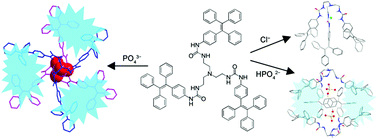Phosphate-induced fluorescence of a tetraphenylethene-substituted tripodal tris(urea) receptor†
Abstract
A tetraphenylethene (TPE)-decorated tripodal tris(urea) ligand L was synthesized, which shows large emission enhancement when binding to an orthophosphate anion (PO43−), but exhibits only weak or no fluorescence with other anions. The anion-binding and fluorescence properties were studied by X-ray crystal structure, NMR and fluorescence spectroscopy, and by DFT computations and the results demonstrate that the different fluorescence performance may be determined by the anion-binding modes (i.e., full- or half-encapsulation).


 Please wait while we load your content...
Please wait while we load your content...